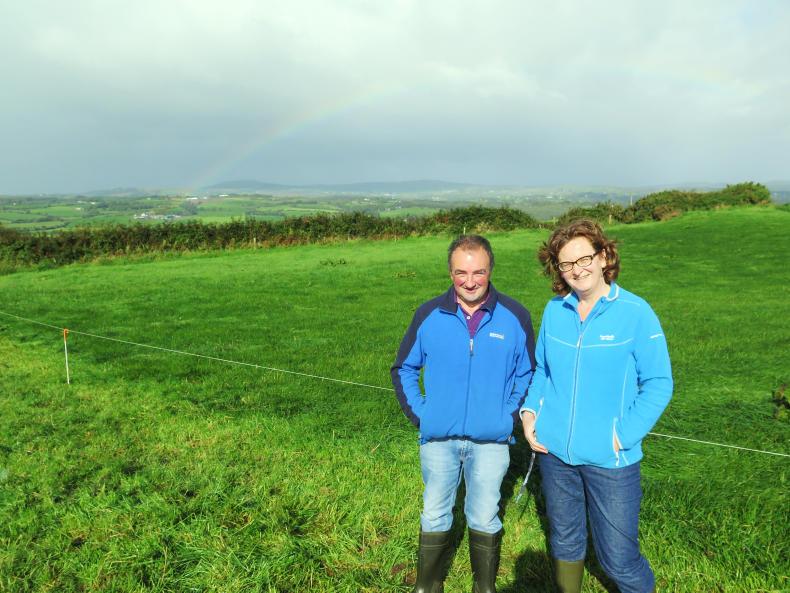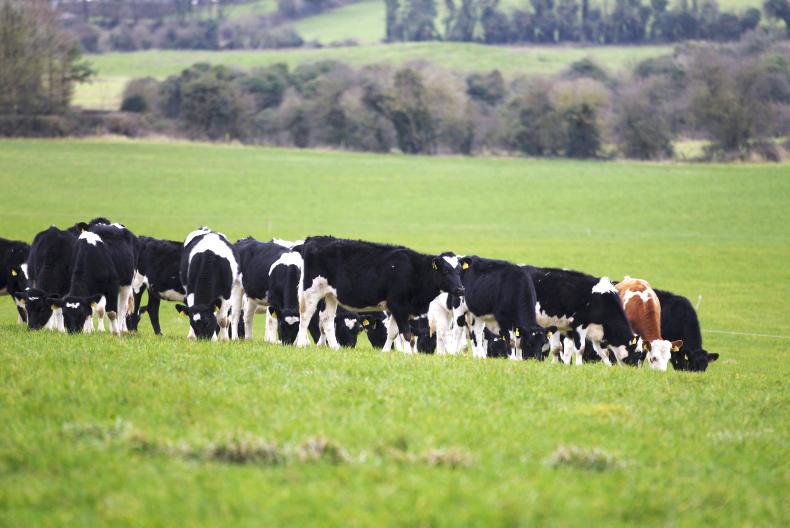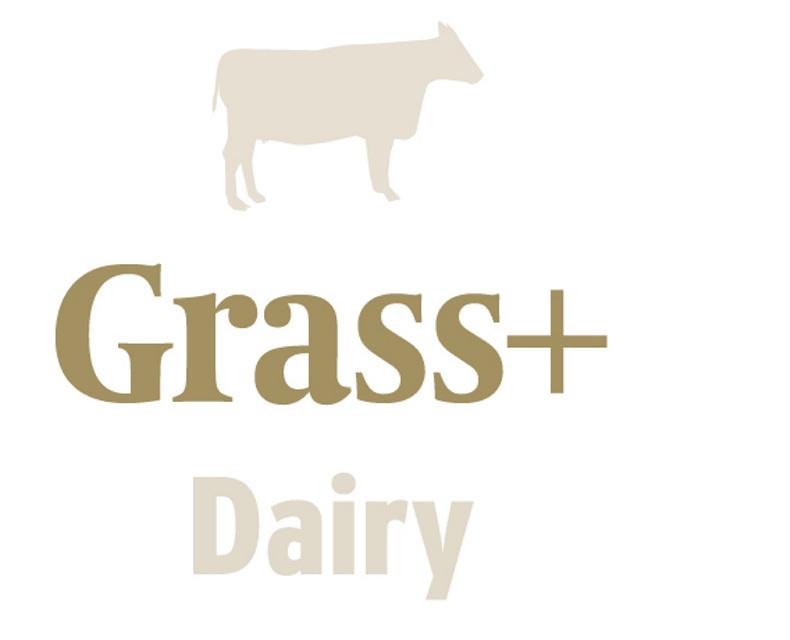The candidates are marked on their achievements in the following areas:
Grazing infrastructure.Grass measurement.Soil and sward management.Sustainability.Outcome in terms of grass production and utilisation, and animal output.Fourteen finalists achieving an average production of 14.5tDM/ha and utilisation of 11tDM/ha have made it into the final round of judging.
Michael and Marguerite Crowley
Cork
The Crowleys are no strangers to competitions having been finalists in this year’s NDC and Kerrygold milk quality awards. The Crowleys are farming near Skibbereen in west Cork – milking 146 cows on a 47 hectare milking block.
This is a real husband and wife team with their children helping out when needs be. Michael and Marguerite’s long term goal is to milk 200 cows with no full-time labour employed so to do this they need to be very efficient.
They are both passionate about grass. Michael credits his previous Teagasc advisor Ger Courtney with getting him into grass measuring which he says allowed him to turn the profitability of the farm around. He says that good grassland management is adding an extra €34,000 a year to the milk cheque with increased fat and protein percent of the milk.
Every time a field is grazed it is recorded on a chart in the farm office. This allows the Crowleys to easily identify any field that is underperforming. The average grass growth between 2015 and 2016 was 14.7t/ha with each paddock being grazed an average of 9.45 times. Grass was measured by both Michael and Marguerite 37 times in each of the last two years.
Nearly all of the slurry is spread by the end of the first round of grazing using a trailing shoe. The whole farm gets urea in February and March and 1.5 bags/acre of 18:6:12 in late March. Depending on the summer either CAN plus S or urea is spread over the summer. The paddocks that are at index one or two for P and K get 1.5 bags/acre of 18:6:12 in June or July. Lime is not forgotten with 50 of the 150 acre milking block getting lime every year. The farm is soil sampled every two years.
The Crowleys have a number of key targets that they don’t want to miss. These are to close the farm at an average farm cover of 700kg/ha and open at 1,000kg/ha. For the mid-season they want a cover per cow of between 180 and 200kg. They start building up grass covers on 1 August and hope to keep grass in the diet until mid-November. The Jersey crossbred cows produce 500kg milk solids/cow.

Wexford
When Michael is not governing the Irish Cattle Breeding Federation (ICBF) he is busy growing grass, and lots of it. The Duncormick, Co Wexford farmer grew an average of 16.1t of grass per hectare in 2015 and 2016 and had 15.3t/ha grown by the time the judges visited in early September and the farm was on track to grow 18t/ha this year. Michael says soil fertility and achieving lots of grazings are key to growing lots of grass.
Michael is farming with his wife Ciara and they have 51 hectares in the milking platform around the yard but 28 hectares up the road that he can graze at the shoulders. This year, the Doran’s are milking 230 cows, up from 186 last year so the stocking rate is very high at 4.5 cows/ha during the summer and 2.9 cows/ha at the shoulders. The land up the road is used for rearing heifers and for silage during the summer.
Michael has been measuring grass for years, even when in beef, so he has a really good handle on the grass growth characteristics of his farm. While the land is considered dry, there is a high clay content and it can be poached easily. Despite this, cows are turned out in early February and graze until late November. Key targets for Michael is to close the farm at an average farm cover of 700kg and to graze pre-grazing covers of around 1,600kg over the summer.
The herd of Jersey crossbred cows were fed an average of 295kg of meal last year and produced 406kg of milk solids each. The farm is well laid out with 29 paddocks and good roadway access throughout. Some of the paddocks closest to the yard have roadways at each end meaning Michael can give cows access at either end in wet weather. This has enabled him to get cows out to grass nearly every day in spring.

Ed (centre) and Jimmy Payne (right) with Tadhg Buckley
Roscommon
Prior to making the decision to go into dairy farming in 2009, the Paynes were large scale beef and sheep farmers. Since switching to dairy they have made massive progress and are milking 295 cows today with a second unit on the way. The Payne’s original base was in Ballymoe, where Jimmy still lives but they decided to build the dairy on their outfarm in Tulsk in Co Roscommon as this was a larger block of free-draining land.
The original block consisted of 50 hectares but this has been expanded to 80 hectares and the whole lot has been reseeded. Ed’s preferred varieties are Aberchoice and Abergain in a 60:40 mix. An extensive network of farm roadways was constructed giving them access to every part of the farm – enabling good grass utilisation at the shoulders.
Ed and Jimmy have grown over 13.8t/ha on average over 2015 and 2016. Grass is measured 41 times a year. The stocking rate on the platform is high at 3.68 cows/ha but silage is brought in from an outfarm and only surplus bales are cut on the milking block. Over 500 bales of surplus grass was made this summer.
Ed and Jimmy have identified soil fertility as an impediment to the farm growing more grass. Phosphorus levels are on the low side so they are targeting as much slurry and chemical P to the low paddocks as they can. They are finding building up P to be a slow and frustrating process. On the other hand pH is excellent with only one paddock under pH of 6.
Last year the herd produced 406kg of milk solids. The herd is a mix of Holstein Friesian and Jersey crossbred cows. Ed and Jimmy are assisted by farm manager Aidan Brosnan.

Denis and Eddie O’Donnell
Tipperary
In 2005 the O’Donnells were milking 70 cows on their 23 hectare milking block of right good land outside the village of Golden in south Tipperary. Eddie went on a trip to New Zealand in 2005 and he said that it opened his eyes. Since then, the O’Donnells have been making steady progress to build a successful farm business.
Land has been bought and leased and a second unit has been taken on so the milking platform is now 116 hectares. Eddie and Denis are milking 318 cows this year so the stocking rate is 2.75 cows/ha on the milking blocks.
Last year the home farm grew over 17t of grass per hectare. The herd produced 460kg of milk solids last year but Eddie said the cows are doing about 30kg/head more in 2017 so reckons they will finish up at 500kg produced per cow.
When the judges visited in early September the O’Donnells had 325kg of meal fed to date. Eddie says feeding not more than 500kg of meal is his aim, as is producing 500kg of milk solids from cows weighing 500kg liveweight. His goal is to grow enough grass to stock the herd at 3 cows/ha and produce enough winter feed from within the system.
Eddie has colour-coded maps showing the paddocks that are low in soil fertility and these are never cut for silage. Only four out of the 19 paddocks on the home farm are low in soil fertility and these paddocks get an extra two bags/acre of 18:6:12.
Eddie says he wouldn’t sleep at night if 105 units of nitrogen per acre are not applied by 1 April as he says this nitrogen is critical for grass growth. He uses a quad and spinner to spread nitrogen in January and February.
Grazing infrastructure is excellent with 5m wide roadways and two 300 gallon water troughs in each paddock. Paddocks are set up to allow for three milkings when the pre-grazing yield is at around 1,500kg.
Read more
Star grazers part I: more finalists in Grassland farmer of the year
The candidates are marked on their achievements in the following areas:
Grazing infrastructure.Grass measurement.Soil and sward management.Sustainability.Outcome in terms of grass production and utilisation, and animal output.Fourteen finalists achieving an average production of 14.5tDM/ha and utilisation of 11tDM/ha have made it into the final round of judging.
Michael and Marguerite Crowley
Cork
The Crowleys are no strangers to competitions having been finalists in this year’s NDC and Kerrygold milk quality awards. The Crowleys are farming near Skibbereen in west Cork – milking 146 cows on a 47 hectare milking block.
This is a real husband and wife team with their children helping out when needs be. Michael and Marguerite’s long term goal is to milk 200 cows with no full-time labour employed so to do this they need to be very efficient.
They are both passionate about grass. Michael credits his previous Teagasc advisor Ger Courtney with getting him into grass measuring which he says allowed him to turn the profitability of the farm around. He says that good grassland management is adding an extra €34,000 a year to the milk cheque with increased fat and protein percent of the milk.
Every time a field is grazed it is recorded on a chart in the farm office. This allows the Crowleys to easily identify any field that is underperforming. The average grass growth between 2015 and 2016 was 14.7t/ha with each paddock being grazed an average of 9.45 times. Grass was measured by both Michael and Marguerite 37 times in each of the last two years.
Nearly all of the slurry is spread by the end of the first round of grazing using a trailing shoe. The whole farm gets urea in February and March and 1.5 bags/acre of 18:6:12 in late March. Depending on the summer either CAN plus S or urea is spread over the summer. The paddocks that are at index one or two for P and K get 1.5 bags/acre of 18:6:12 in June or July. Lime is not forgotten with 50 of the 150 acre milking block getting lime every year. The farm is soil sampled every two years.
The Crowleys have a number of key targets that they don’t want to miss. These are to close the farm at an average farm cover of 700kg/ha and open at 1,000kg/ha. For the mid-season they want a cover per cow of between 180 and 200kg. They start building up grass covers on 1 August and hope to keep grass in the diet until mid-November. The Jersey crossbred cows produce 500kg milk solids/cow.

Wexford
When Michael is not governing the Irish Cattle Breeding Federation (ICBF) he is busy growing grass, and lots of it. The Duncormick, Co Wexford farmer grew an average of 16.1t of grass per hectare in 2015 and 2016 and had 15.3t/ha grown by the time the judges visited in early September and the farm was on track to grow 18t/ha this year. Michael says soil fertility and achieving lots of grazings are key to growing lots of grass.
Michael is farming with his wife Ciara and they have 51 hectares in the milking platform around the yard but 28 hectares up the road that he can graze at the shoulders. This year, the Doran’s are milking 230 cows, up from 186 last year so the stocking rate is very high at 4.5 cows/ha during the summer and 2.9 cows/ha at the shoulders. The land up the road is used for rearing heifers and for silage during the summer.
Michael has been measuring grass for years, even when in beef, so he has a really good handle on the grass growth characteristics of his farm. While the land is considered dry, there is a high clay content and it can be poached easily. Despite this, cows are turned out in early February and graze until late November. Key targets for Michael is to close the farm at an average farm cover of 700kg and to graze pre-grazing covers of around 1,600kg over the summer.
The herd of Jersey crossbred cows were fed an average of 295kg of meal last year and produced 406kg of milk solids each. The farm is well laid out with 29 paddocks and good roadway access throughout. Some of the paddocks closest to the yard have roadways at each end meaning Michael can give cows access at either end in wet weather. This has enabled him to get cows out to grass nearly every day in spring.

Ed (centre) and Jimmy Payne (right) with Tadhg Buckley
Roscommon
Prior to making the decision to go into dairy farming in 2009, the Paynes were large scale beef and sheep farmers. Since switching to dairy they have made massive progress and are milking 295 cows today with a second unit on the way. The Payne’s original base was in Ballymoe, where Jimmy still lives but they decided to build the dairy on their outfarm in Tulsk in Co Roscommon as this was a larger block of free-draining land.
The original block consisted of 50 hectares but this has been expanded to 80 hectares and the whole lot has been reseeded. Ed’s preferred varieties are Aberchoice and Abergain in a 60:40 mix. An extensive network of farm roadways was constructed giving them access to every part of the farm – enabling good grass utilisation at the shoulders.
Ed and Jimmy have grown over 13.8t/ha on average over 2015 and 2016. Grass is measured 41 times a year. The stocking rate on the platform is high at 3.68 cows/ha but silage is brought in from an outfarm and only surplus bales are cut on the milking block. Over 500 bales of surplus grass was made this summer.
Ed and Jimmy have identified soil fertility as an impediment to the farm growing more grass. Phosphorus levels are on the low side so they are targeting as much slurry and chemical P to the low paddocks as they can. They are finding building up P to be a slow and frustrating process. On the other hand pH is excellent with only one paddock under pH of 6.
Last year the herd produced 406kg of milk solids. The herd is a mix of Holstein Friesian and Jersey crossbred cows. Ed and Jimmy are assisted by farm manager Aidan Brosnan.

Denis and Eddie O’Donnell
Tipperary
In 2005 the O’Donnells were milking 70 cows on their 23 hectare milking block of right good land outside the village of Golden in south Tipperary. Eddie went on a trip to New Zealand in 2005 and he said that it opened his eyes. Since then, the O’Donnells have been making steady progress to build a successful farm business.
Land has been bought and leased and a second unit has been taken on so the milking platform is now 116 hectares. Eddie and Denis are milking 318 cows this year so the stocking rate is 2.75 cows/ha on the milking blocks.
Last year the home farm grew over 17t of grass per hectare. The herd produced 460kg of milk solids last year but Eddie said the cows are doing about 30kg/head more in 2017 so reckons they will finish up at 500kg produced per cow.
When the judges visited in early September the O’Donnells had 325kg of meal fed to date. Eddie says feeding not more than 500kg of meal is his aim, as is producing 500kg of milk solids from cows weighing 500kg liveweight. His goal is to grow enough grass to stock the herd at 3 cows/ha and produce enough winter feed from within the system.
Eddie has colour-coded maps showing the paddocks that are low in soil fertility and these are never cut for silage. Only four out of the 19 paddocks on the home farm are low in soil fertility and these paddocks get an extra two bags/acre of 18:6:12.
Eddie says he wouldn’t sleep at night if 105 units of nitrogen per acre are not applied by 1 April as he says this nitrogen is critical for grass growth. He uses a quad and spinner to spread nitrogen in January and February.
Grazing infrastructure is excellent with 5m wide roadways and two 300 gallon water troughs in each paddock. Paddocks are set up to allow for three milkings when the pre-grazing yield is at around 1,500kg.
Read more
Star grazers part I: more finalists in Grassland farmer of the year
















SHARING OPTIONS